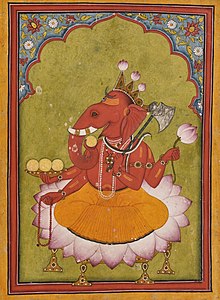Basohli | |
|---|---|
Town | |
| Coordinates: 32°30′N 75°49′E / 32.50°N 75.82°E | |
| Country | |
| Union Territory | Jammu and Kashmir |
| District | Kathua |
| Elevation | 1,200 m (3,900 ft) |
| Population (2011) | |
| • Total | 5,433 |
| Languages | |
| • Official | Dogri, Pahari, Hindi, English |
| Time zone | UTC+5:30 (IST) |

Basohli (formerly Vishwasthali) is a town near Kathua in Kathua district in the union territory of Jammu and Kashmir, India. It is situated on the right bank of the River Ravi, at an altitude of 1876 ft. The town was founded by Raja Bhupat Pal sometime in 1635. It was known for the palaces which are now in ruins and miniatures paintings (the Basohli school of Pahari painting). The Battle of Basoli was fought in this region.
Basohli is known for its unique 'Basohli Paintings'. In the late 17th century, Basohli emerged as a great centre of Pahari paintings. According to well known Dr. Herman Goltz, "Basohli painting are among the great achievements of Indians". Their central inspiration is Vashnavism, the themes have been taken from the spics and the Puranas.
The different themes of the paintings are religious (Gita Govinda and Ramayana), secular, historical, contemporary and literary. Besides the paintings bring out extreme emotion combined with a lyrical sense of Basohli landscape.
Basohli paintings are said to have been described as 'Poems in colours'. The paintings are marked by strikingly blazing colours bold lines, rich symbols and peculiar features giving an accumulative impact of highly sensuous environs.
- ^ National Museum, New Delhi. For description of the work see: Martin-Dubost (1997), p. 73, which says: "Ganesha getting ready to throw his lotus. Basohli miniature, circa 1730. National Museum, New Delhi. Attired in an orange dhoti, his body is enitirely red. On the three points of his tiny crown, budding lotuses have been fixed. Gaṇeśa holds in his two right hands the rosary and a cup filled with three modakas (a fourth substituted by the curving trunk is just about to be tasted). In his two left hands, Gaṇeśa holds a large lotus above and an axe below, with its handle leaning against his shoulder. In the Mudgalapurāṇa (VII, 70), in order to kill the demon of egotism (Mamāsura) who had attacked him, Gaṇeśa Vighnarāja throws his lotus at him. Unable to bear the fragrance of the divine flower, the demon surrenders to Gaṇeśa."

